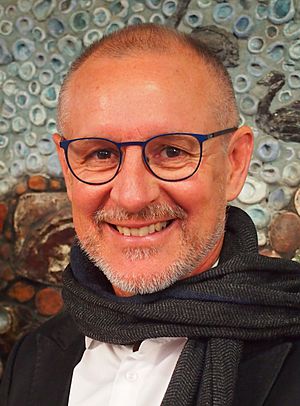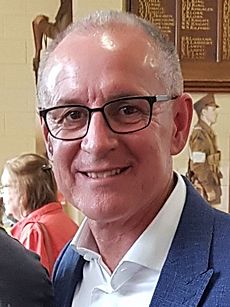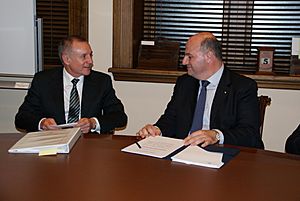Jay Weatherill facts for kids
Quick facts for kids
Jay Weatherill
|
|
|---|---|

Weatherill in 2018
|
|
| 45th Premier of South Australia | |
| In office 21 October 2011 – 19 March 2018 |
|
| Monarch | Elizabeth II |
| Governor | Kevin Scarce Hieu Van Le |
| Preceded by | Mike Rann |
| Succeeded by | Steven Marshall |
| Deputy | John Rau |
| Treasurer of South Australia | |
| In office 21 January 2013 – 26 March 2014 |
|
| Preceded by | Jack Snelling |
| Succeeded by | Tom Koutsantonis |
| Leader of the South Australian Labor Party | |
| In office 21 October 2011 – 9 April 2018 |
|
| Deputy | John Rau |
| Preceded by | Mike Rann |
| Succeeded by | Peter Malinauskas |
| Minister for Education | |
| In office 25 March 2010 – 21 October 2011 |
|
| Premier | Mike Rann |
| Preceded by | Jane Lomax-Smith |
| Succeeded by | Grace Portolesi |
| Minister for Environment and Conservation | |
| In office 24 July 2008 – 25 March 2010 |
|
| Premier | Mike Rann |
| Preceded by | Gail Gago |
| Succeeded by | Paul Caica |
| Minister for Ageing, Disability and Housing | |
| In office 5 March 2004 – 24 July 2008 |
|
| Premier | Mike Rann |
| Preceded by | office established |
| Succeeded by | office abolished |
| Minister for Administrative Services | |
| In office 6 March 2002 – 5 March 2004 |
|
| Premier | Mike Rann |
| Preceded by | Diana Laidlaw |
| Succeeded by | Trish White |
| Member for Cheltenham | |
| In office 9 February 2002 – 17 December 2018 |
|
| Preceded by | Murray De Laine |
| Succeeded by | Joe Szakacs |
| Personal details | |
| Born |
Jay Wilson Weatherill
3 April 1964 Adelaide, South Australia, Australia |
| Political party | Australian Labor Party (SA) |
| Spouse | Melissa Bailey |
| Children | 2 |
| Alma mater | University of Adelaide |
| Profession | Lawyer |
Jay Wilson Weatherill (born 3 April 1964) is a former Australian politician who served as the 45th Premier of South Australia. A premier is the leader of a state government. He held this top job from October 2011 to March 2018.
Weatherill was a member of the South Australian Labor Party. He represented the area of Cheltenham in the state parliament from 2002 until he retired in 2018.
His party, Labor, was in power in South Australia for 16 years, from 2002 to 2018. This was the longest time a state Labor government had ever been in charge in South Australia. After losing the 2018 election, Weatherill stepped down as leader.
Contents
Early Life and Education
Jay Weatherill was born in the western suburbs of Adelaide. His father, George Weatherill, was also a politician.
He went to Henley High School for his secondary education. After high school, he studied at the University of Adelaide, where he earned degrees in law and economics.
Before entering politics, Weatherill worked as a lawyer. In 1995, he started his own law firm that focused on helping workers with legal issues. He continued to work as a lawyer until he was elected to parliament in 2002.
Political Career
In 2002, Weatherill was elected to represent the electorate of Cheltenham. Because his party won the election, he immediately became a government minister. A minister is a politician in charge of a specific government department.
Over the years, he was the minister for many different areas, including:
- Aboriginal Affairs and Reconciliation
- Environment and Conservation
- Education
- Housing
In 2011, the Labor Party chose Weatherill to be its new leader, replacing Mike Rann. This meant he also became the new Premier of South Australia.
Time as Premier
Weatherill became the 45th Premier of South Australia on 21 October 2011. He led the state for two terms.
First Term (2011–2014)
One of Weatherill's first major actions was to fight for a better deal for the River Murray. His government helped secure more water for the river to keep it healthy.
In 2013, he opened the South Australian Health and Medical Research Institute (SAHMRI). This building is famous for its unique design, which looks like a cheese grater. It is a major center for medical research, with over 700 scientists.
During this time, the government also faced challenges. A plan to expand the huge Olympic Dam mine was cancelled. Also, the car company Holden announced it would stop making cars in South Australia, which led to job losses.
A big success for Weatherill was campaigning to have Australia's new submarines built in South Australia. This project was expected to create many jobs in the state.
2014 Election
The 2014 state election was very close. Neither the Labor Party nor the rival Liberal Party won enough seats to form a government on their own. This is called a hung parliament.
The decision came down to an independent member of parliament, Geoff Brock. He decided to support Labor, which allowed Weatherill to remain as premier and form a minority government.
Second Term (2014–2018)
In his second term, Weatherill focused on new ideas and projects for South Australia.
Nuclear Fuel Cycle Royal Commission
In 2015, Weatherill started a Nuclear Fuel Cycle Royal Commission. This was a major investigation into whether South Australia should become more involved with nuclear materials, such as storing nuclear waste from other countries. The commission suggested that a storage facility could be safe and good for the state's economy, but the idea did not get enough support to go ahead.
Energy Plan
After a major blackout in 2016 left the whole state without power, Weatherill announced a big energy plan in 2017. The plan included building a new government-owned power station and the world's largest lithium-ion battery. This giant battery, built by Tesla and known as the Hornsdale Power Reserve, helps to keep the power supply stable.
In 2018, his government also announced a plan to create the world's largest "virtual power plant." This project aimed to give free solar panels and battery systems to 50,000 homes.
Space and Defence
In 2017, Weatherill announced the South Australian Space Industry Centre. This was a step towards creating a national space agency in Australia. He also expanded a government department to focus on both Defence and Space Industries, helping to attract high-tech jobs to the state.
2018 Election Defeat
At the 2018 election, the Labor government was defeated by the Liberal Party, led by Steven Marshall. Labor had been in power for a record 16 years.
The day after the election, Weatherill announced he would step down as the leader of the Labor Party. He was succeeded by Peter Malinauskas. Weatherill retired from parliament completely at the end of 2018.
Life After Politics
After leaving politics, Weatherill has taken on several new roles. In 2019, he became a professor at the University of South Australia. He also moved to Perth to lead a program for the Minderoo Foundation focused on early childhood development.
In 2021, he was awarded the Officer of the Order of Australia, a high honour, for his service to South Australia. In 2025, he was appointed to the council of the National Gallery of Australia.
Personal Life
Weatherill is married to Melissa, and they have two daughters. He is a supporter of the Port Adelaide Football Club in the Australian Football League (AFL).
See also
- 2018 South Australian state election
- Australian Labor Party (South Australian Branch)
- Cabinet of South Australia
- Weatherill Ministry




